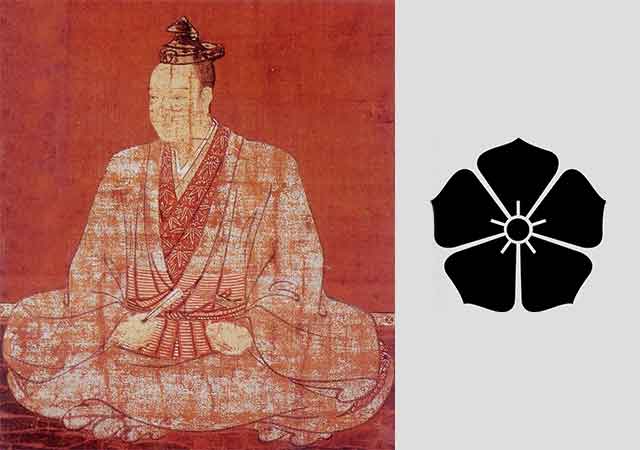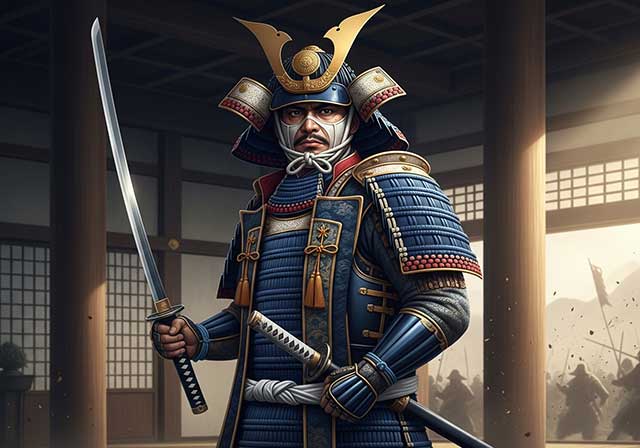
Akechi Mitsuhide (March 10, 1528 – July 2, 1582), initially known as Jubei within his clan and later as Koreto Hyuga no Kami by title, was a notable Japanese samurai general during the Sengoku period. He is most famously remembered as the assassin of Oda Nobunaga. Mitsuhide first served as a bodyguard to Ashikaga Yoshiaki and later became a distinguished general under the daimyo Nobunaga during his campaign for political unification in Japan.
Mitsuhide's rebellion against Nobunaga in the Honno-ji Incident of 1582, for reasons unknown, led to Nobunaga's tragic seppuku in Kyoto, as he was left unprotected. Mitsuhide then sought to establish himself as shogun, but was pursued by Nobunaga's successor, Toyotomi Hideyoshi, and was ultimately defeated in the Battle of Yamazaki.
Mitsuhide was believed to be born on March 10, 1528, at Tara Castle in Mino Province, which corresponds to modern-day Kani, Gifu Prefecture. He hailed from the Toki-Akechi family, a branch of the shugo Toki clan, and was rumored to be a childhood friend or cousin of Nohime. Raised to be a general under the governance of Saito Dosan and the Toki clan in Mino Province, Mitsuhide sided with Dosan when his son, Saito Yoshitatsu, rebelled in 1556.
Mitsuhide's service extended to being one of the guardians of the "wandering shogun" Ashikaga Yoshiaki under Hosokawa Fujitaka. At one point, he suggested Oda Nobunaga as the official protector for Yoshiaki, who had initially sought Asakura Yoshikage for the role.
By 1567, after Nobunaga's conquest of Mino Province and the subsequent passage through Omi Province to Kyoto, Nobunaga, Yoshiaki, and Mitsuhide arrived in the capital, where Nobunaga facilitated Yoshiaki's ascension as the next shogun. Mitsuhide played a crucial role in the defense of Yoshiaki during the "Honkokuji Incident" in 1569, ultimately solidifying his loyalty to Nobunaga.
Mitsuhide continued to distinguish himself in various campaigns under Nobunaga's banner, including the Siege of Kanegasaki in Echizen Province and the Siege of Shigisan against Matsunaga Hisahide. He also played a key role in the Siege of Ishiyama Hongan-ji against Ikko-ikki rebellion in 1576.
However, tensions between Mitsuhide and Nobunaga escalated over time, exacerbated by public insults directed at Mitsuhide. The breaking point came with the Siege of Shigisan, which is often linked to the Honnoji Incident.
The Honnoji Incident in 1582 marked a pivotal moment in Mitsuhide's history. Ignoring Nobunaga's orders to march west, Mitsuhide led an army against Nobunaga's position at Honno-ji. The temple was surrounded and set ablaze, leading to Nobunaga's demise. Mitsuhide claimed responsibility for the act, shocking the capital.
In a bid to secure his position, Mitsuhide looted Azuchi Castle to reward his men. However, his attempts at garnering support from the Imperial Court and other clans were in vain. Toyotomi Hideyoshi, alerted to Nobunaga's assassination, swiftly marshaled his forces and confronted Mitsuhide at the Battle of Yamazaki on July 2, 1582. Outnumbered and unprepared, Mitsuhide was defeated in the ensuing battle.
See also
-
Uemura Masakatsu

Masakatsu was a member of the Uemura clan and the son of Uemura Masatada; from an early age he served Tokugawa Ieyasu. During the Ikkō-ikki uprising in Mikawa Province in 1563, having converted from the Jōdo Shinshū Buddhist sect to the Jōdoshū sect, he took part in suppressing the rebels. After these events, Masakatsu was appointed a military governor and was granted land holdings. According to a number of sources, he was one of the so-called “Three Governors of Mikawa” (Mikawa sanbugyō), together with Amano Yasukage (1537–1613) and Koriki Kiyonaga (1530–1608).
-
Tomoe Gozen

Gozen is regarded as one of the few historically documented examples of true female warriors of feudal Japan, known as onna-musha or onna-bugeisha. Although Japanese history records countless women who at various times were forced to take up arms—for example, in defense of their castles—Tomoe Gozen was, without any doubt, a genuinely skilled and accomplished fighter. She was the wife of Kiso (Minamoto) Yoshinaka, although The Tale of the Heike describes her more as a female vassal. Yoshinaka rose in rebellion against the Taira clan and, in 1184, captured Kyoto after his victory at the Battle of Kurikawa. After the Taira were driven into the western provinces, Yoshinaka began insistently asserting that he alone was worthy of assuming leadership of the Minamoto clan and taking on the mantle of its head.
-
Tachibana Muneshige

Tachibana Muneshige was born the eldest son of Takahashi Shigetane, one of the principal retainers of the Ōtomo clan and commander of Iwaya Castle. In childhood, he bore the name Senkumamaru. His early years coincided with a period of intense military confrontation between the Ōtomo clan and other powerful warrior houses of Kyūshū—namely the Shimazu, Akizuki, and Ryūzōji clans.
-
Tachibana Dosetsu

Tachibana Dōsetsu is the name by which Hetsugi Akitsura is more widely known; the name of this lineage is also found read as Hekki or Bekki. For a long period, Akitsura served the Ōtomo clan, the daimyō of Bungo Province, and took part in wars against the Ōuchi family, the principal enemies of the Ōtomo in northwestern Kyushu. In the 1560s, Akitsura seized the castle of the Tachibana clan, which had rebelled against the Ōtomo, and thereafter adopted the surname Tachibana. Around the same time, he took Buddhist vows and assumed the name Dōsetsu, which means “Snowy Road.”
-
Taira no Masakado

Taira no Masakado embodied the quintessential samurai of his era—self-assured, harsh, and unyielding. In his youth, he served in the palace guard and repeatedly proved his bravery while suppressing unrest. Thanks to these achievements, Masakado sought the post of chief of the capital’s military-police office (the kebiishi-chō), but he was rejected: by that time, nearly all court positions—now little more than privileged sinecures—were controlled by members of the powerful Fujiwara clan.
-
Sakakibara Yasumasa

Yasumasa was the second son of Sakakibara Nagamasa and was born in Ueno in Mikawa Province. From a young age, he began serving Tokugawa Ieyasu and eventually rose to the position of one of his most trusted generals. His wife was the daughter of Osuga Yasutaka. Ieyasu first noticed the young Yasumasa during the suppression of the Ikkō-ikki uprising in Mikawa in 1564. Thanks to his demonstrated abilities, Yasumasa was granted the privilege of using the character “yasu”—the second character of Ieyasu’s own name—in his own. Although he was the second child in his family, he became his father’s heir, though the exact reasons for this remain unknown.
-
Sakai Tadatsugu

Tadatsugu was one of the most renowned generals serving Tokugawa Ieyasu. After Ieyasu broke ties with the Imagawa clan, Tadatsugu—an ardent supporter of this decision—was granted command of Yoshida Castle in 1565, which controlled the coastal road from Tōtomi to Mikawa. During the Battle of Mikatagahara in 1573, he held the right flank of the Tokugawa forces even when the troops sent by Oda fled under the assault of the Takeda army. In the Battle of Nagashino in 1575, he personally requested permission to carry out a night attack on the Takeda camp, which he executed brilliantly together with Kanamori Nagachika.
-
Ryuzoji Takanobu

Takanobu was the eldest son of Ryūzōji Takaie and the great-grandson of Ryūzōji Iekane. His father was killed by a man named Baba Yoritiku in 1544. At a young age, Takanobu took Buddhist vows and received the monastic name Engetsu. However, around the age of eighteen, he returned to secular life, and in 1548, after the death of Ryūzōji Tanehide, he became the head of both branches of the Ryūzōji family.

